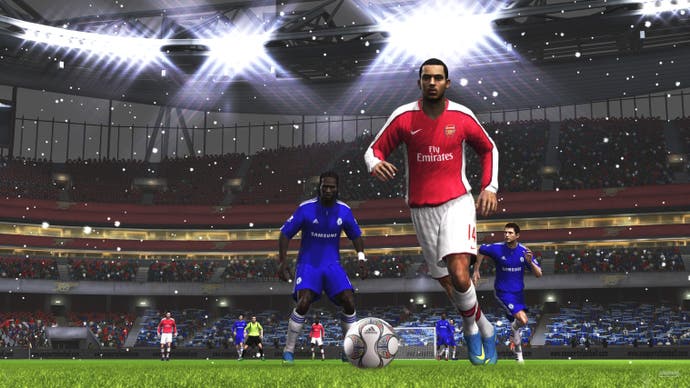FIFA 10
Kicking our way through EA Canada.
Five years ago, it would have shocked no one. Turning up at a FIFA event in London and being introduced to a set-piece creator would have made perfect sense. It's another line for the back of the box. Five years later though, perhaps it should be shocking. Nowadays you almost get the sense that FIFA developers David Rutter and Gary Paterson delight in making the box designers squirm. "I'm militant," creative director Paterson tells me as we sit down in one of EA Canada's many conference rooms a month later. "I'm not doing anything just for the back of the box. It has to be somehow linked to a fundamental of the game." And by the game, he means football.
FIFA's transformation from glossy licensed dirge into the footballers' football game of choice has been led by men like Paterson and Rutter, and of course, despite appearances, the set-piece creator is another example of why their approach has worked: its marketability is incidental. "That's something that arguably real footballers do," lead producer Rutter says of the set-piece creator. "Sunday league teams do if they're having a practice... I've been making football videogames for something like 13 years now, Gary's probably not far off it, and there's a bunch of us who've probably only worked on footy games, and that's where we've come from."
The vast majority of the things I've come to Canada to see and discuss are far less marketable, however. They're the guts of the game: changes to pace and stamina, the way goalkeepers behave, new ways for wingers to beat their man, how the game applies error to shots, headers and long-range passes, curbing acceleration... Stuff like that. Stuff that matters.

The biggest footballing revelation in FIFA 10 is the introduction of 360-degree dribbling, and the difference it makes is considerable. It means that you can turn in the exact direction you want and put the ball exactly where you intend, providing you can point the analogue stick in the right direction (no mean feat, as Geometry Wars players will appreciate). It also means that you can use the full width of the pitch: rather than having to change sprint direction in 45-degree increments, you can angle yourself to move away from a chasing defender into the remaining margin, increasing your chances of pulling away or drawing a foul. Changes elsewhere wring further value from it. Last year's contextual knock-ons allowed you to tap the ball past a defender and then run onto it, but in FIFA 10 your player is programmed to run around the defender if his path is blocked (some even run around the wrong way, Bergkamp-style).

That, it turns out, is one of the easier changes to appreciate, because a great many others happen away from the ball. Attackers will saunter on the halfway line when their team is not in possession, while players near to the ball will hustle along and orientate themselves to face it, which helps when they suddenly become involved by one of the now-faster cross-field passes. A player facing the ball is naturally better-placed to trap it and move off quickly than someone who has to turn first. Last year they didn't always do that, but this year they do, and along with reworked run cycles and urgency, it contributes to a greater sense of fluidity. FIFA 10 also behaves more credibly when you get into advanced positions. Last year's floaty shots are gone after EA adjusted a couple of key physics effects on the ball, and this means that players like Steven Gerrard can hit it harder and more accurately on their favoured foot.



